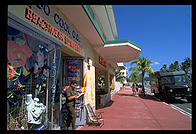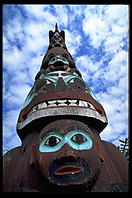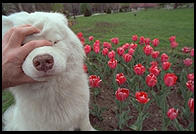
Nikon 20/2.8 AF lens
by Philip Greenspun; created 1995
Site Home : Photography : Nikon 20/2.8 AF lens

by Philip Greenspun; created 1995
Site Home : Photography : Nikon 20/2.8 AF lens
 There isn't a whole lot to say about a
fixed 20 lens. It is sharp, contrasty, and a bit fragile. All of Nikon's "very
wide" lenses have "close-range correction" (CRC). This is a "floating element"
that moves relative to the other pieces of glass inside the lens as you focus.
Most lenses just move a whole rack of optics in and out as you focus. They are
optimized for subjects 3 meters away but perform adequately at infinity or
close-up. I don't understand optics, but I know that this doesn't work for
extreme wide angles. You lose a lot of optical quality close up if you don't
change the configuration. This is very important because most of the interesting
pictures that one can take with a 20 are "near-far" images, with a relatively
close main subject and an interesting background far away.
There isn't a whole lot to say about a
fixed 20 lens. It is sharp, contrasty, and a bit fragile. All of Nikon's "very
wide" lenses have "close-range correction" (CRC). This is a "floating element"
that moves relative to the other pieces of glass inside the lens as you focus.
Most lenses just move a whole rack of optics in and out as you focus. They are
optimized for subjects 3 meters away but perform adequately at infinity or
close-up. I don't understand optics, but I know that this doesn't work for
extreme wide angles. You lose a lot of optical quality close up if you don't
change the configuration. This is very important because most of the interesting
pictures that one can take with a 20 are "near-far" images, with a relatively
close main subject and an interesting background far away.
Photojournalism has been getting wider and wider over the years. A 20 is a good lens for showing a group of people, one or two people close up, and the background.
Make sure to keep the lens level to the horizon and then crop out uninteresting foreground. This makes the lens a reasonable substitute for a perspective correction lens or view camera.
I broke my 20, I'm not even sure how. S.K. Grimes in Boston fixed it for $60 and said that it was a very common failure. Some little plastic piece. The image at right was taken in Berlin with the broken lens. The depth of field looked very strange in the viewfinder and in fact you can see that there is an awful lot of soft focus for a 20.
I paid about $400 for mine back in 1991 or something. I'm sure it has gone up since then. Off-brand lenses are much much cheaper than manufacturer wide angles. That's because they don't have a floating element (see above) and hence are incapable of quality results when focussed close.
 I've become very fond of my Canon EOS 20-35/2.8
zoom. Not because of the optical quality, which is obviously less than the Nikon
fixed 20/2.8, but because of the flexibility. Nikon's 20-35/2.8 zoom is allegedly
marvelous. That's what I would buy today instead of a fixed 20. However, don't be
tempted to substitute an off-brand 20-35 zoom for the Nikon 20. You won't get
comparable results.
I've become very fond of my Canon EOS 20-35/2.8
zoom. Not because of the optical quality, which is obviously less than the Nikon
fixed 20/2.8, but because of the flexibility. Nikon's 20-35/2.8 zoom is allegedly
marvelous. That's what I would buy today instead of a fixed 20. However, don't be
tempted to substitute an off-brand 20-35 zoom for the Nikon 20. You won't get
comparable results.
Text and pictures copyright 1991-1995 Philip Greenspun